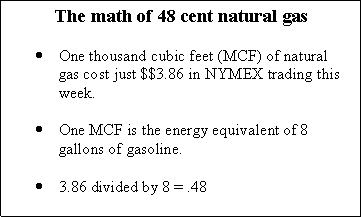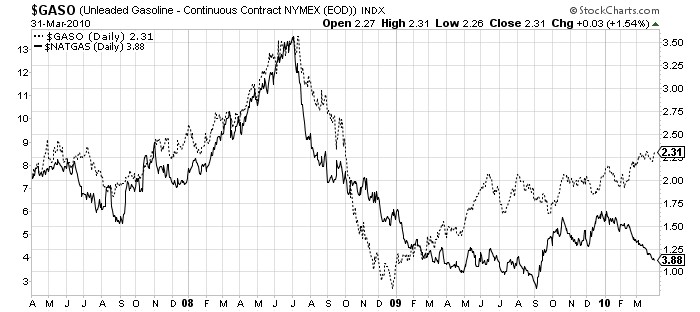- How to
buy gas for 48 cents per gallon – no joke - Why to
buy now - What
to buy now
You probably remember when gasoline cost 48 cents a
gallon. It was in 1974 – not so long
ago, really.
Inflation adjusted for 2009 dollars, gas was never that
cheap though. It bottomed in 1999 at
about $1.40.

So I realize it sounds too good to be true to suggest that
you can buy gas for 48 cents today. With
most of us paying close to $3/gallon it’s just a ridiculous claim.
And of course, there is a catch. Consider it a small April Fools day
hoax. I’m not talking about gasoline…I’m
talking about natural gas. You might be
cursing my misdirection – but that’s exactly why I’m excited about this ultra-cheap
resource: Most people don’t care about natural gas; they take it for
granted. It’s super plentiful in the U.S.
and it seems like every day there’s another massive natural gas discovery. President Obama just proposed a plan to allow
drilling along the Atlantic coast, the north coast of Alaska
and the eastern Gulf of Mexico yesterday that will
likely unearth even more natural gas. 
We have so much that we literally don’t know what to do with
it. Long term, we’ll put it to use,
whether it’s to power automobiles, electricity generation, to heat more of our
homes, or to be used in industry.
But right now, it’s just sitting around. Natural gas producers have started to “store
it in-ground” – meaning they’re just sitting on it, waiting for the price to
rise.
It’s cheap. The
natural gas energy equivalent of one gallon of gasoline costs just 48
cents.
According to a Financial Times article in March of this year
we have “enough [natural] gas to last… for a century.”
Oil tycoon T. Boone Pickens says that if we can’t figure out
how to capitalize on this massive energy resource, then we’re “the dumbest
people in the world…”
Well, I don’t think we’re the dumbest people in the world –
it just might take gasoline at $5 a gallon to spur us in the right direction. But right now you and I can capitalize on
this opportunity by buying stock in natural gas companies.
The biggest blockade to adopting natural gas for automobiles
is the same as for every other alternative energy source: infrastructure. There are very few natural gas filling
stations in the United
States. There are only a handful of manufacturers making vehicles that run on
natural gas. So, today there’s just no
economy of scale for the resource.
But it’s a potential tipping-point situation. The diversion between natural gas and
gasoline will eventually make natural gas the only economic choice for manufacturers
of new vehicles.

The chart plots the price of one gallon of gasoline as the
dotted line, and the price of 1,000 cubic feet of natural gas as the solid
line.
Demand for natural gas vehicles will skyrocket as gasoline
gets more expensive. Remember all of the
hubbub about the Toyota
(NYSE: TM) Prius when gas prices spiked in the summer of 2008? They couldn’t sell them fast enough.
So buying stock natural gas companies is a long-term
play. But even in the shorter-term,
natural gas prices should rise. Could it
go lower? Sure. But not much lower. I’m not timing the market – I’m buying
because natural gas is cheap.
And today, you can buy natural gas companies for extremely cheap. I’m talking cheaper than you’ll likely ever
see them again.
At today’s prices, you’re locking in the upside of the
inevitability that the U.S.
and eventually the whole world will have to find another fuel source for personal
and commercial vehicles.
Some of my favorite natural gas companies are royalty
trusts. These companies pay no corporate
tax as long as they pay out at least 90% of their profits in the form of
dividends.
And since natural gas is so cheap and these companies don’t
get any of the same love and attention from the mainstream media as oil
companies, their dividend yields are massive.
One company I’m looking at right now is Hugoton Royalty
Trust (NYSE: HGT).
It pays a 10.4% dividend.
The best part? This
company has almost zero exposure to fixed costs in the industry – which can be substantial. That’s because they just collect royalties on
the sale of natural gas through XTO Energy (NYSE: XTO).
These royalty companies do two things: they loan money to
companies in the exploration and pre-production stages – then get paid a floating
royalty rate on any profits for the lifetime of the other company.
There’s only two downsides for this type of company.
1) If natural gas prices go lower Hugoton would receive smaller
royalties from XTO. Natural gas prices
are already rock bottom, so this scenario isn’t likely.
2) If XTO runs out of natural gas to sell, they cease paying
royalties to HGT. But that’s not a
likelihood. XTO has proven natural gas
reserves of over 12.50 trillion cubic feet – that’s the equivalent of 100
billion gallons of gasoline – or nearly enough to supply every single vehicle
in the United States
for a whole year.
So they’re not running out of natural gas any time
soon. A $10,000 stake in Hugoton would
pay you $1,040 in royalties every year, which can help take the sting out of
higher gas prices in the meantime. This
company is a great income investment in the sector – but there’s a better way
to play the trend of rising natural gas prices.
Chief Analyst Ian Wyatt recently selected another natural
gas company for Energy World Profits, his advisory service all about energy
investments.
It’s even bigger than XTO with over 14 trillion cubic feet
of natural gas. Low natural gas prices
have pushed this company well below the buy-up to price and today this company
is almost as cheap as it’s been in the past 6 months.
There’s no better safe-play in the natural gas sector. This company is the best-of-class for the
field, and buying it today would be like buying Standard Oil with John D.
Rockefeller. As the world slowly weans
itself off gasoline, natural gas will be the only alternative standing.
Click here to get the full details Energy World Profits –
and Ian’s favorite natural gas stock right now – including a way to get a free tank of gasoline.
Good investing,
Kevin McElroy
Editor,
Resource Prospector
 Facebook
Facebook
 Twitter
Twitter